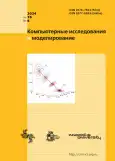Simulation of two-phase flow in porous media using an inhomogeneous network model
- 作者: Shabbir K.U.1, Izvekov O.Y.1, Konyukhov A.V.1,2
-
隶属关系:
- Moscow Institute of Physics and Technology (National Research University)
- Joint Institute for High Temperatures, Russian Academy of Sciences
- 期: 卷 16, 编号 4 (2024)
- 页面: 913-925
- 栏目: MODELS IN PHYSICS AND TECHNOLOGY
- URL: https://bakhtiniada.ru/2076-7633/article/view/306593
- DOI: https://doi.org/10.20537/2076-7633-2024-16-4-913-925
- ID: 306593
如何引用文章
全文:
详细
We present an inhomogeneous two-dimensional network model of two-phase flow in porous media. The edges of the network are assumed to be capillary tubes of different radii. We propose a new algorithm for handling phase fluxes at the nodes of this network model. We perform two test problems and show that the two-phase flow in this inhomogeneous network model demonstrates properties that are analogous to those of real porous media: capillary imbibition, dependence of capillary pressure on saturation and effect of capillary forces in two-phase displacement. The two test problems are: the counter-current imbibition and the twophase displacement in a periodically inhomogeneous porous medium. In the former problem, we implement a network consisting of two regions: a region of low-permeability with thin capillaries surrounded by a region of high-permeability with thick capillaries, initially saturated with wetting and nonwetting incompressible fluids, respectively. Capillary equilibrium is established due to counter-current imbibition by a region. We examine the dependence: of saturation of the wetting fluid with respect to time in the regions, and of capillary pressure on the current saturation. We have obtained a qualitative agreement with the known experimental and theoretical results, which will further allow us to use this network model to verify homogenized models of capillary nonequilibrium. In the latter problem, we consider the two-phase displacement, where the network is initially saturated with nonwetting fluid. Then wetting fluid is injected through a boundary at a constant rate. We analyze the saturation with respect to the axis which is along the applied pressure gradient for various moments in time with various values of coefficients of surface tension. The results show that for lower values of coefficient of surface tension, the wetting fluid prefers to invade through the thicker tubes, and in the case of higher values, through thinner tubes.
作者简介
Kafi Shabbir
Moscow Institute of Physics and Technology (National Research University)
编辑信件的主要联系方式.
Email: kafiulshabbir@phystech.edu
O. Izvekov
Moscow Institute of Physics and Technology (National Research University)
Email: izvekov_o@inbox.ru
Andrey Konyukhov
Moscow Institute of Physics and Technology (National Research University); Joint Institute for High Temperatures, Russian Academy of Sciences
Email: konyukhov_av@mail.ru
Candidate of physico-mathematical sciences
参考
- E. Aker, et al., “A two-dimensional network simulator for two-phase flow in porous media”, Transport in Porous Media, 32 (1998), 163–186.
- G. Barenblatt, T. Patzek, D. Silin, “The mathematical model of nonequilibrium effects in water–oil displacement”, SPE Journal, 8:4 (2003), 409–416.
- G. Barenblatt, I. Zheltov, I. Kochina, “Basic concepts in the theory of seepage of homogeneous liquids in fissured rocks”, Journal of Applied Mathematics and Mechanics, Pergamon, 24:5 (1960), 1286–1303.
- M. Blunt, et al., “Pore-scale imaging and modelling”, Advances in Water Resources, 51 (2013), 197–216.
- S. Chen, G. Doolen, “Lattice Boltzmann method for fluid flows”, Annual Review of Fluid Mechanics, 30:1 (1998), 329–364.
- O. Coussy, Poromechanics, John Wiley & Sons, 2004, 315 pp.
- I. Fatt, “The network model of porous media. 3. Dynamic properties of networks with tube radius distribution”, Transactions of the American Institute of Mining and Metallurgical Engineers, 207:7 (1956), 164–181.
- S. Hassanizadeh, “Continuum description of thermodynamic processes in porous media: Fundamentals and applications”, in Modeling Coupled Phenomena in Saturated Porous Materials, 2004, 179–223.
- S. Hassanizadeh, W. Gray, “High velocity flow in porous media”, Transport in Porous Media, 2 (1987), 521–531.
- V. I. Kondaurov, “A non-equilibrium model of a porous medium saturated with immiscible fluids”, Journal of Applied Mathematics and Mechanics, 73:1 (2009), 88–102.
- V. I. Kondaurov, “The thermodynamically consistent equations of a thermoelastic saturated porous medium”, Journal of Applied Mathematics and Mechanics, 71:4 (2007), 562–579.
- A. Konyukhov, L. Pankratov, A. Voloshin, Homogenized Non-equilibrium Models of Two-phase Flow in Fractured Porous Media, Fizmatkniga, Moscow, 2017, 187 pp.
- A. Konyukhov, L. Pankratov, A. Voloshin, “The homogenized Kondaurov type non-equilibrium model of two-phase flow in multiscale non-homogeneous media”, Physica Scripta, 94:4 (2019).
- N. Labed, L. Bennamoun, J. Fohr, “Experimental study of two-phase flow in porous media with measurement of relative permeability”, Fluid Dynamics & Materials Processing, 8:4 (2012), 423–436.
- J. Liu, L. Lin, R. Song, J. Zhao, “A pore scale modeling of fluid flow in porous medium based on Navier–Stokes equation”, Disaster Advances, 6 (2013), 5–11.
- P. Meakin, A. Tartakovsky, “Modeling and simulation of pore-scale multiphase fluid flow and reactive transport in fractured and porous media”, Reviews of Geophysics, 47:3 (2009).
- T. Ramstad, C. Berg, K. Thompson, “Pore-scale simulations of single- and two-phase flow in porous media: approaches and applications”, Transport in Porous Media, 130 (2019), 77–104.
- K. Shabbir, “Simulation of two-phase flow in porous media using a two-dimensional network model”, Proceedings of the 65th All-Russia Scientific Conference MIPT, v. 78, Fizmatkniga, Moscow, 2023, 205–206.
- B. Su, C. Sanchez, X. Yang, “Insights into hierarchically structured porous materials: from nanoscience to catalysis, separation, optics, energy, and life science”, in Hierarchically Structured Porous Materials, Wiley Online Library, 2012, 1–27.
- S. Whitaker, “Flow in porous media. I: A theoretical derivation of Darcy’s law”, Transport in Porous Media, 1 (1986), 3–25.
补充文件









